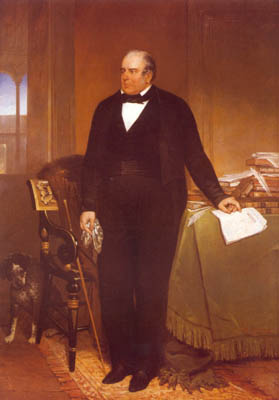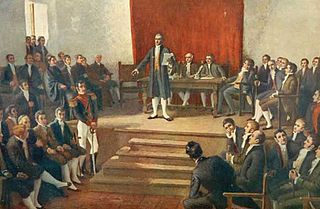This article needs additional citations for verification .(February 2024) |
| |||||
| Decades: | |||||
|---|---|---|---|---|---|
| See also: | Other events in 1811 · Timeline of Chilean history | ||||
The following lists events that happened during 1811 in Chile .
This article needs additional citations for verification .(February 2024) |
| |||||
| Decades: | |||||
|---|---|---|---|---|---|
| See also: | Other events in 1811 · Timeline of Chilean history | ||||
The following lists events that happened during 1811 in Chile .
President of the First Government Junta of Chile (1810): Mateo de Toro Zambrano (-February 26, Juan Martínez de Rozas (February 26-April 2), Fernando Márquez de la Plata (April 2-July 4)
President of the First National Congress: Juan Antonio Ovalle (July 4–20), Moderate, Martin Calvo Encalada (July 20-August 11)
President of the Provisional Executive Authority: Martín Calvo Encalad, (20 July-4 September), Patriot
President of the Executive Court: Juan Enrique Rosales (4 September–November 16)
President of the Provisional Government Junta: José Miguel Carrera (16 November–December 13), Patriot
Supreme Provisional Authority: José Miguel Carrera (December 13-), Patriot

Fernando de Errázuriz y Martínez de Aldunate, also known as Fernando Errázuriz Aldunate, was a Chilean political figure. He served as provisional president of Chile in 1831.

Agustín Manuel de Eyzaguirre y Arechavala was a Chilean political figure. He served as Provisional President of Chile between 1826 and 1827.

Juan Martínez de Rozas Correa was a Chilean lawyer and politician, he was also the first leader in the Chilean fight for independence.

The Chilean War of Independence was a military and political event that allowed the emancipation of Chile from the Spanish Monarchy, ending the colonial period and initiating the formation of an independent republic.

Francisco Antonio García Carrasco Díaz was a Spanish soldier and Royal Governor of Chile. His political relations with Juan Martinez de Rozas and a smuggling scandal involving the frigate Scorpion destroyed what little authority he had, and required that he surrender his post to Mateo de Toro Zambrano President of the first government board. He was the last governor to rule before the Chilean independence movement swept the country.

Mateo de Toro Zambrano y Ureta, 1st Count of La Conquista, was a prominent Spanish military and political figure of Criollo descent. He held the position of a knight in the Order of Santiago and was the lord of the Toro-Zambrano estate.

The Chilean Civil War of 1829–1830 was a civil war in Chile fought between conservative Pelucones and liberal Pipiolos forces over the constitutional regime in force. This conflict ended with the defeat of the liberal forces and the approval of a new constitution in 1833, that was in force until 1925.

The First Government Junta of Chile, officially the Provisional Government Junta of the Kingdom in the name of Ferdinand VII, was the organization established to rule post-colonial Chile following the deposition and imprisonment of King Ferdinand VII of Spain by Napoleon Bonaparte. It was the earliest step in the Chilean struggle for independence, and the anniversary of its establishment is celebrated as the national day of Chile.
Government Junta of Chile, also known as the Provisional Junta, was the political structure established to rule Chile following the Military Coup organized by Juan Martínez de Rozas and José Miguel Carrera. It lasted until replaced by the December Junta.

Bishop José Antonio Martínez de Aldunate y Garcés de Marcilla was a Chilean Bishop and member of the First Government Junta of Chile.

Fernando Márquez de la Plata y Orozco was a Spanish colonial functionary, and a member of the First Government Junta of Chile.

José Miguel Infante y Rojas was a Chilean statesman and political figure. He served several times as deputy and minister, and was the force behind the Federalist movement in that country.

The president of the Chamber of Deputies of Chile is the highest authority of the Chamber of Deputies of Chile. The office was established in 1811 by the First National Congress of Chile.
The following lists events that happened during 1812 in Chile.
The following lists events that happened during 1813 in Chile.

The Regency of the Mexican Empire was a period of transition in the history of the Mexican monarchy in the absence of the Emperor of Mexico and presided by a president of the same during the First Mexican Empire (1821–1823) and the Second Mexican Empire (1863–1867). The regency is the government of a State during the minor age, absence or incapacity of its legitimate prince.
The Revolution of September 4, 1811, also known as Golpe del 4 de septiembre or simply as Primer golpe de Carrera, was a military movement in Chile. Its main objective was to change the conformation of the nascent National Congress, transforming it into a Congress more inclined to separatist ideas. The movement had as military leaders the Carrera brothers, among them José Miguel, who later became the main character of the so-called Patria Vieja (1810-1814). On the political side, the main instigators of the coup movement were the Larraín family with Fray Joaquín Larraín at their head.

The First Chilean National Congress was the first legislative body established in Chile. It was inaugurated on July 4, 1811, being one of the oldest congresses in Latin America. It was convened to decide the best kind of government for the Kingdom of Chile during the captivity of King Ferdinand VII in the hands of Napoleon. It was in session from July 4 until December 2, when it was dissolved by a coup d'état by General José Miguel Carrera.